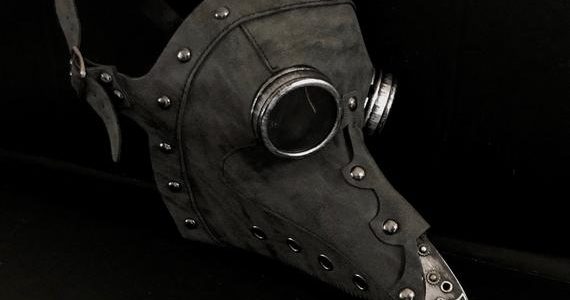

L'Orme wrote that the mask had a "nose half a foot long, shaped like a beak, filled with perfume with only two holes, one on each side near the nostrils, but that can suffice to breathe and to carry along with the air one breathes the impression of the drugs enclosed further along in the beak." The garment was impregnated with similar fragrant items as the mask. The garments were first mentioned by a physician to King Louis XIII of France, Charles de L'Orme, who wrote in a 1619 plague outbreak in Paris that he developed an outfit made of Moroccan goat leather, including boots, breeches, a long coat, hat, and gloves modeled after a soldier's canvas gown which went from the neck to the ankle. Often, these plague doctors were the last thing a patient would see before death therefore, the doctors were seen as a foreboding of death. Depictions of the beaked plague doctor rose in response to superstition and fear about the unknown source of the plague. The beaked plague doctor inspired costumes in Italian theatre as a symbol of general horror and death, though some historians insist that the plague doctor was originally fictional and inspired the real plague doctors later. The exact origins of the costume are unclear, as most depictions come from satirical writings and political cartoons.

The canes were also used to keep people away and to remove clothing from plague victims without having to touch them. Doctors used wooden canes in order to point out areas needing attention and to examine patients without touching them. The wide-brimmed leather hat indicated their profession. Doctors believed the herbs would counter the "evil" smells of the plague and prevent them from becoming infected. The purpose of the mask was to keep away bad smells, known as miasma, which were thought to be the principal cause of the disease. The beak could hold dried flowers (commonly roses and carnations), herbs (commonly lavender and peppermint), camphor, or a vinegar sponge, as well as juniper berry, ambergris, cloves, labdanum, myrrh, and storax. The mask had two small nose holes and was a type of respirator which contained aromatic items. The typical mask had glass openings for the eyes and a curved beak shaped like a bird's beak with straps that held the beak in front of the doctor's nose. The typical costume consists of an ankle-length overcoat and a bird-like beak mask, often filled with sweet or strong-smelling substances (commonly lavender), along with gloves, boots, a wide-brimmed hat, and an outer over-clothing garment.

Plague doctor outfit from Germany (17th century)


 0 kommentar(er)
0 kommentar(er)
